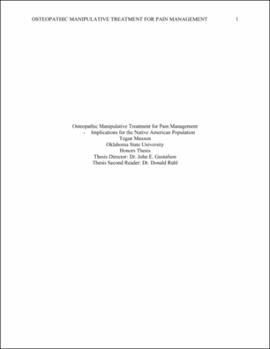| dc.contributor.author | Maxson, Tegan | |
| dc.date.accessioned | 2021-04-20T13:37:13Z | |
| dc.date.available | 2021-04-20T13:37:13Z | |
| dc.date.issued | 2019-07-24 | |
| dc.identifier | oksd_maxson_HT_2019 | |
| dc.identifier.uri | https://hdl.handle.net/11244/329365 | |
| dc.description.abstract | Osteopathic Medicine was founded by Dr. Andrew Taylor Still in the late 1800s (8). The basis of the founding of Osteopathic Medicine was to find a way to better the available medical practices which were unadvanced and crude during this time period (8). Osteopathic Manipulative Therapy (OMT) came about by the correlation between disease and a musculoskeletal abnormality that was discovered by Dr. A.T. Still (8). From this discovery, a disease treatment method that utilized pressure techniques and the musculoskeletal system was created and is now known as OMT Osteopathic Manipulative Therapy (8). | |
| dc.description.abstract | Two widely utilized forms of pain management are over-the-counter (OTC) and prescription pain medications (1,6). OTC medications work by inhibiting the production of prostaglandins (3). Prescription opioid medications initiate their activity by binding to an opiate receptor (6). Opioid medications have many downfalls when considering chronic pain management (6), which include poor effectiveness rates, addiction and misuse (15). | |
| dc.description.abstract | In comparison to other ethnic groups in the United States, Native American communities have higher drug overdose and mortality rates associated with overdose (16). One report indicated study that up to 30 % of the population in one reservation used oxycontin for a non-medical use (17). Fifty-nine percent of the individuals using oxycontin in this reservation who were not prescribed this drug by a physician claimed they took it for pain relief (17). | |
| dc.description.abstract | The purpose of this review is to identify the potential effectiveness of Osteopathic Manipulative Therapy as a chronic pain management technique. To do so, the PubMed database was searched for articles related to the terms, osteopathic manipulative therapy, OMT, pain, and chronic pain. This review is based on the articles found from this search. | |
| dc.description.abstract | The articles presented in this thesis provide evidence that of OMT reduced or relieved pain associated with chronic low back and pain, in pregnant and postpartum women and in patients with: cancer; cystic fibrosis; chronic migraine; spinal cord injuries; shoulder problems; and traumatic knee arthritis. Additional research work pertaining to the effects of OMT on multiple sclerosis management, wound healing, diaphragm motion, pulmonary function, and cerebral perfusion, are also included in this thesis. | |
| dc.description.abstract | The impact of OMT being utilized as a pain management technique is not completely understood. However, if OMT could be utilized for pain management, then opioids use could be curtailed. A reduction in opioid use could help reduce the complications with these drugs such as dependence, addiction, and drug tolerance. In addition, clinics and medical centers could then be established for the purpose of using OMT for pain alleviation. | |
| dc.description.abstract | Currently, some Native American tribes are promoting the use of OMT through their tribal nation’s healthcare system. For instance, the Choctaw Nation of Oklahoma offers OMT services at two locations (26). If further in depth research supported OMT for pain relief, clinics offering OMT could be established in all Native American tribal nations and reservations and be promoted as a pain management resource. If this occurred, then OMT could be used to combat the opioid and prescription drug problems in the American Indian populations. | |
| dc.format | application/pdf | |
| dc.language | en_US | |
| dc.rights | Copyright is held by the author who has granted the Oklahoma State University Library the non-exclusive right to share this material in its institutional repository. Contact Digital Library Services at lib-dls@okstate.edu or 405-744-9161 for the permission policy on the use, reproduction or distribution of this material. | |
| dc.title | Osteopathic manipulative treatment for pain management: Implications for the Native American population | |
| osu.filename | oksd_maxson_HT_2019.pdf | |
| dc.type.genre | Honors Thesis | |
| dc.type.material | Text | |
| dc.contributor.director | Gustafson, John | |
| dc.contributor.facultyreader | Ruhl, Donald | |
| thesis.degree.discipline | Biochemistry and Molecular Biology | |
| thesis.degree.grantor | Oklahoma State University | |
